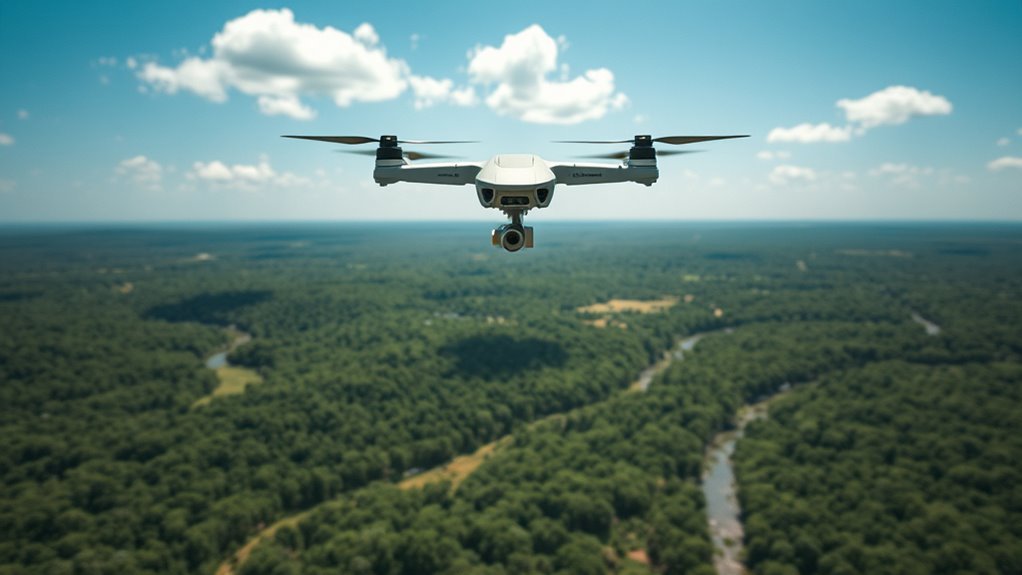To use the Feather Drone Repo effectively, start by familiarizing yourself with its structure. Set up your development environment with Git, Node.js, and a code editor. Explore various projects and tools within the repo for customization options. Make necessary adjustments to hardware and firmware for improved performance. Contribute by following project guidelines and engaging with the community for support. As you progress, you’ll discover more powerful features and opportunities to enhance your drone experience.
Understanding the Feather Drone Repo Structure

When you immerse yourself in the Feather Drone Repo, it’s essential to grasp its structure to navigate it effectively. Understanding the repo organization helps you locate files and resources quickly, enhancing your productivity. The file hierarchy is designed to segregate components, making it easier to find specific modules or documentation. Typically, you’ll encounter directories for source code, examples, and tests, each clearly labeled to streamline your workflow. Familiarizing yourself with this layout not only saves time but also empowers you to contribute more effectively. As you explore, pay attention to naming conventions and the purpose of each directory, as these are crucial for maintaining order and clarity within the repo. Embrace this structure, and your development experience will be greatly improved.
Setting Up Your Development Environment

With a solid understanding of the Feather Drone Repo structure, you’re ready to set up your development environment. Begin by installing essential development tools like Git, Node.js, and your preferred code editor. Next, verify your environment configuration aligns with the repo’s specifications. This step is vital for maintaining compatibility and efficiency.
Here’s a quick overview of key tools and configurations:
| Tool | Purpose | Installation Link |
|---|---|---|
| Git | Version control | [Download Git](https://git-scm.com) |
| Node.js | JavaScript runtime | [Download Node.js](https://nodejs.org) |
| Code Editor | Code writing | [VSCode](https://code.visualstudio.com) |
Once you’ve completed these steps, you’re well on your way to contributing with freedom and creativity!
Exploring Available Projects and Tools

In this section, you’ll explore the various project categories available in the Feather Drone Repo and how to effectively utilize the tools at your disposal. Understanding these categories and techniques will enhance your development process and help you leverage community contributions. Let’s break down these elements to maximize your workflow and project outcomes.
Project Categories Overview
As you explore the Feather Drone Repo, you’ll find a diverse array of project categories designed to enhance your drone development experience. These categories include aerial photography, racing drones, and autonomous navigation, each offering unique project types tailored to specific needs. By engaging with these categories, you can streamline your development process and focus on the tools and resources most relevant to your objectives. The category benefits are clear: they provide organized access to documentation, sample codes, and community support, allowing you to leverage existing knowledge and innovations. Whether you’re a hobbyist or a professional, understanding these project categories will empower you to maximize your drone’s potential and foster your creative pursuits in the drone ecosystem.
Tool Utilization Techniques
Effective utilization of the Feather Drone Repo’s tools can greatly enhance your project outcomes. To maximize your efficiency, implement robust tool integration strategies. Start by exploring existing projects within the repo to identify compatible tools that align with your objectives. Use version control systems to maintain a seamless workflow and manage changes effectively.
Adopt effective workflow practices by organizing your tools and resources for quick access. Creating standardized templates for common tasks can streamline your processes, allowing you to focus on innovation. Additionally, leverage automation features available in the repo to reduce manual workload and enhance accuracy. By taking these steps, you’ll not only boost productivity but also gain the freedom to experiment and create unique drone applications tailored to your needs.
Community Contributions Highlight
Exploring the Feather Drone Repo reveals a wealth of community contributions that can greatly enhance your projects. You’ll find a variety of tools and code snippets developed by fellow enthusiasts, each aimed at improving functionality and performance. Engaging with these community contributions not only accelerates your learning but also enriches your project outcomes.
Customizing Your Drone
While many users may be satisfied with their Feather Drone’s out-of-the-box performance, customizing your drone can greatly enhance its capabilities and tailor it to your specific needs. One effective way to achieve this is through drone modifications. Start by exploring various hardware upgrades, such as enhanced propellers or better cameras, which can improve flight efficiency and capture quality. Additionally, consider firmware customization to optimize flight parameters and add new features. By adjusting settings like PID values or flight modes, you can fine-tune your drone’s responsiveness and stability. Remember, the Feather Drone Repo has a wealth of resources and community contributions that can guide you in making these enhancements, ensuring you get the most out of your flying experience. Furthermore, leveraging advanced data encryption will help protect your customized features from potential cyber threats. By using Coretronic’s software for data-driven insights, you can maximize your drone’s performance and adaptability in various environments.
Contributing to Existing Projects
When contributing to existing projects in the Feather Drone Repo, it’s essential to understand the project’s guidelines to guarantee your contributions align with the maintainers’ expectations. You’ll need to submit code changes following the established processes, which can vary from project to project. Additionally, effective communication with maintainers can facilitate smoother collaboration and improve the quality of your contributions.
Understanding Project Guidelines
To effectively contribute to existing projects in the Feather Drone Repo, you need to familiarize yourself with the project’s guidelines, as they provide essential standards for collaboration. Understanding these guidelines guarantees you meet project requirements and enhances documentation clarity, leading to a more cohesive effort. Here are key aspects to reflect on:
- Review the README – This is your roadmap; it outlines everything you need to know.
- Understand the Code Style – Consistency in coding makes collaboration smoother and more enjoyable.
- Follow Issue Templates – They guide you in reporting bugs or suggesting features effectively.
- Engage with the Community – Building relationships fosters a supportive environment, driving innovation and freedom.
Embrace these guidelines to make your contributions impactful!
Submitting Code Changes
Submitting code changes to existing projects in the Feather Drone Repo requires a clear understanding of the process to secure your contributions are accepted smoothly. Start by forking the repository and creating a new branch for your changes. This version control practice helps keep your work organized and separate from the main codebase. After implementing your changes, commit your code with clear, descriptive messages. When you’re ready, push your branch to your fork and create a pull request. This initiates a code review, where maintainers will evaluate your modifications for quality and compatibility. Be prepared to address feedback and make adjustments as necessary. Following these steps secures your contributions align with the project’s standards and enhances collaboration within the community.
Communicating With Maintainers
Effective communication with maintainers is key to successful contributions in the Feather Drone Repo. To guarantee your interactions are productive, consider the following:
- Understand maintainer expectations: Familiarize yourself with their guidelines and project goals.
- Be concise: Keep your messages clear and to the point, which saves time for everyone involved.
- Provide effective feedback: When discussing issues or suggestions, focus on solutions rather than problems. This fosters a collaborative atmosphere.
- Be respectful: Acknowledge maintainers’ efforts and expertise; a little appreciation can go a long way.
Staying Updated With New Features and Releases
As you explore the Feather Drone Repo, staying updated with new features and releases is essential for maximizing its potential. Regularly check the official repository for feature announcements and release notifications. You can also subscribe to a mailing list or follow relevant forums to receive instant updates on improvements and bug fixes. Consider setting up notifications on platforms like GitHub to be alerted of changes in real-time. Engaging with the community through social media channels can provide insights into upcoming features and user experiences. By keeping yourself informed, you’ll harness the full power of the Feather Drone Repo, ensuring you’re always equipped with the latest tools and enhancements to enhance your projects.
Frequently Asked Questions
What Are the System Requirements for Using Feather Drone Repo?
To utilize the Feather Drone Repo, guarantee your system meets the minimum specifications. Pay attention to performance metrics, as they directly impact your experience. Upgrading components can enhance functionality and provide greater freedom in drone operations.
How Can I Troubleshoot Common Issues With Feather Drone?
Ever wondered how to tackle common issues with your Feather Drone? Start by ensuring battery calibration is correct and check flight stabilization settings. These steps can enhance performance and minimize disruptions during your flying experience.
Are There Tutorials Available for Beginners?
Yes, there’re plenty of tutorial resources available for you. Look for beginner tips on platforms like YouTube and forums, where experienced users share insights and practical advice to enhance your skills with the Feather Drone.
Can I Use Feather Drone Repo on Different Operating Systems?
Yes, you can use the Feather Drone Repo across various operating systems. However, you’ll need to account for operating system differences to guarantee full feather drone compatibility, optimizing performance regardless of your chosen platform.
Is There a Community Forum for Support and Discussions?
Yes, there’s a community forum for support and discussions. You’ll find user experiences shared there, and it’s important to adhere to community guidelines for respectful and productive interactions. Engage freely and learn from others!

